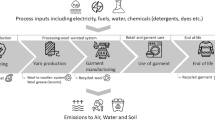Abstract
Background, Aim and Scope
The issues of environmental impacts of concrete have become important since many major infrastructure owners are now requiring environmentally sustainable design (ESD). The carbon dioxide (CO2) emissions are often used as a rating tool to compare the environmental impact of different construction materials in ESD. Currently, the designers are forced to make estimates of CO2 emissions for concrete in ESD based on conjecture rather than data. The aim of this study was to provide hard data collected from a number of quarries and concrete manufacturing plants so that accurate estimates can be made for concretes in ESD.
Materials and Methods
This paper presents the results of a research project aimed to quantify the CO2 emissions associated with the manufacture and placement of concrete. The life cycle inventory data was collected from two coarse aggregates quarries, one fine aggregates quarry, six concrete batching plants and several other sources. The results are presented in terms of equivalent CO2 emissions. The potential of fly ash and ground granulated blast furnace slag (GGBFS) to reduce the emissions due to concrete was investigated. A case study of a building is also presented.
Results
Portland cement was found to be the primary source of CO2 emissions generated by typical commercially produced concrete mixes, being responsible for 74% to 81% of total CO2 emissions. The next major source of CO2 emissions in concrete was found to be coarse aggregates, being responsible for 13% to 20% of total CO2 emissions. The majority contribution of CO2 emissions in coarse aggregates production was found to from electricity, typically about 80%. Blasting, excavation, hauling and transport comprise less than 25%. While the explosives had very high emission factors per unit mass, they contribute very small amounts (<0.25%) to coarse aggregate production, since only small quantities are used. Production of a tonne of fine aggregates was found to generate 30% to 40% of the emissions generated by the production of a tonne of coarse aggregates. Fine aggregates generate less equivalent CO2 since they are only graded, not crushed. Diesel and electricity were found to contribute almost equally to the CO2 emissions due to fine aggregates production. Emission contributions due to admixtures were found to be negligible. Concrete batching, transport and placement activities were all found to contribute very small amounts of CO2 to total concrete emissions.
Discussion
The CO2 emissions generated by typical normal strength concrete mixes using Portland cement as the only binder were found to range between 0.29 and 0.32 t CO2-e/m3. GGBFS was found to be capable of reducing concrete CO2 emissions by 22% in typical concrete mixes. Fly ash was found to be capable of reducing concrete CO2 emissions by 13% to 15% in typical concrete mixes.
Conclusions
The results presented are based on typical concrete manufacturing and placement methods in Australia. The data presented in this paper can be utilized to compare green house gas emissions due to concrete with those associated with alternative construction materials.
Recommendations and Perspectives
The various rating schemes used to compare alternative construction materials should use models such as the one presented in this paper, based on hard data so that reliable comparisons can be made. A case study is presented in this paper demonstrating how the results may be utilized.
Similar content being viewed by others
References
Jönsson Å, Björklund T, Tillman A-M (1998): LCA of Concrete and Steel Building Frames. Int J LCA 3(4) 216–224
Schuurmans A, Rouwette R, Vonk N, Broers J, Rijnsburger H, Pietersen H (2005): LCA of Finer Sand in Concrete. Int J LCA 10(2) 131–135
Humphreys K, Mahasenan M (2002): Toward a Sustainable Cement Industry. Substudy 8, Climate Change. World Business Council for Sustainable Development
Commonwealth of Australia (2004): Australian Greenhouse Office Factors and Methods Workbook. Australian Greenhouse Office
Cuevas-Cubria C, Riwoe D (2006): Australian Energy: National and State Projections to 2029–30. Australian Bureau of Agricultural and Resource Economics
CIF (2003): Cement Industry Environment Report, Cement Industry Federation
Collins F, Sanjayan J G (2002): The Challenge of the Cement Industry Federation Towards the Reduction of Greenhouse Emissions, Towards a Better Built Environment — Innovation, Sustainability, Information Technology. Proceedings of the International Association of Bridge and Structural Engineers Symposium, Melbourne
Heidrich C, Hinczak I, Ryan B (2005): SCM’s potential to lower Australia’s greenhouse gas emissions profile, Iron and Steel Slag Products: A Significant Time of Scarcity. Australasian Slag Association Conference, Sydney
John VM (2003): On the sustainability of concrete. UNEP Industry and Environment, pp 62–63
Gartner E (2004): Industrially interesting approaches to ‘low CO2’ cements. Cement and Concrete Research 34, 1489–1498
Josa A, Aguado A, Heino A, Byars E, Cardim A (2003): Comparative analysis of available life cycle inventories of cement in the EU. Cement and Concrete Research 34, 1313–1320
Office of Housing internet site (2005): http://hnb.dhs.vic.gov.au/ooh/oohninte.nsf/frameset/Ooh? Opendocument, accessed 9 August 2005, last updated 20 July 2005
Personal communication with John MacDonald, DesignInc Melbourne Pty Ltd, 15 July 2005
Pade C, Guimaraes M (2006): The CO2 Uptake of Concrete during a 100 year Perspective, Proceedings of Advances in Cement and Concrete X — Sustainability. Davos, Switzerland, July 2006, Engineering Conferences International, pp 114–119
Author information
Authors and Affiliations
Corresponding author
Additional information
ESS-Submission Editor: Dr. Stefanie Hellweg (stefanie.hellweg@ifu.baug.ethz.ch)
Rights and permissions
About this article
Cite this article
Flower, D.J.M., Sanjayan, J.G. Green house gas emissions due to concrete manufacture. Int J Life Cycle Assess 12, 282–288 (2007). https://doi.org/10.1065/lca2007.05.327
Received:
Accepted:
Published:
Issue Date:
DOI: https://doi.org/10.1065/lca2007.05.327




